Wikipedia:Picture of the day/October 2021
|
Featured picture tools: |
These featured pictures, as scheduled below, appeared as the picture of the day (POTD) on the English Wikipedia's Main Page in October 2021. Individual sections for each day on this page can be linked to with the day number as the anchor name (e.g. [[Wikipedia:Picture of the day/October 2021#1]] for October 1).
You can add an automatically updating POTD template to your user page using {{Pic of the day}} (version with blurb) or {{POTD}} (version without blurb). For instructions on how to make custom POTD layouts, see Wikipedia:Picture of the day.Purge server cache
October 1

|
The Australian owlet-nightjar (Aegotheles cristatus) is a nocturnal bird found in open woodland across Australia and in southern New Guinea. Despite not being an owl, it is colloquially known as the moth owl, and is the most common nocturnal bird in Australia; despite suffering from predation and competition by introduced species, it is not considered to be threatened. This Australian owlet-nightjar was photographed in a nesting hollow in Castlereagh Nature Reserve, New South Wales. Photograph credit: John Harrison
Recently featured:
|
October 2

|
Paul von Hindenburg (2 October 1847 – 2 August 1934), was a German general and statesman who led the Imperial German Army during World War I. In 1925, he returned to public life to become the second elected president of the Weimar Republic. While he was personally opposed to Adolf Hitler and his Nazi Party, he nonetheless played a major role in the political instability that resulted in their rise to power, ultimately agreeing to appoint Hitler as Chancellor of Germany in January 1933 after the Nazis had become the largest party in the Reichstag. This 1914 photograph of Hindenburg in military uniform was taken by the German photographer Nicola Perscheid. Photograph credit: Nicola Perscheid; restored by Adam Cuerden
Recently featured:
|
October 3
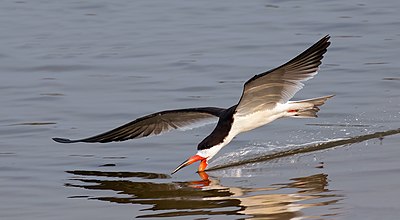
|
The black skimmer (Rynchops niger) is a tern-like bird in the gull family Laridae, breeding in North and South America. Skimmers have the lower mandible (jawbone) and bill longer than the upper ones, which allows them to fly low over the water surface, skimming the water for small fish, insects, crustaceans and molluscs. This black skimmer was photographed fishing while in flight over the Rio Negro in the Pantanal, an area of tropical wetland in southwestern Brazil. Photograph credit: Charles James Sharp
Recently featured:
|
October 4
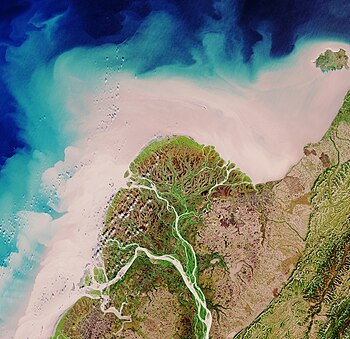
|
The Yukon Delta is a river delta formed by the Yukon River as it drains into the Bering Sea. It is part of the larger Yukon–Kuskokwim Delta, which includes the delta of the Kuskokwim River. The Yukon River rises in British Columbia, Canada, and flows through Yukon before entering the U.S. state of Alaska. This August 2017 satellite image of the Yukon Delta shows how the river branches into numerous distributary channels that meander through the low-lying terrain on their way to the sea. The sandy colour of these channels and the coastal water is indicative of the marine sediment the river carries to the sea at this time of year. Photograph credit: European Space Agency / Sentinel-2
Recently featured:
|
October 5

|
The Hofburg Palace is the former principal imperial palace of the Habsburg dynasty. Located in the center of Vienna, it was built in the 13th century and expanded several times. Empress Maria Theresa had a 17th-century opera house converted into the dance and concert halls now known as the Redoutensäle, forming the Redoute Wing. This 1763 oil painting by Martin van Meytens depicts the hall on the occasion of the wedding supper of Princess Isabella of Parma and Joseph II, Holy Roman Emperor, who were married on 5 October 1760. Painting credit: Martin van Meytens
Recently featured:
|
October 6
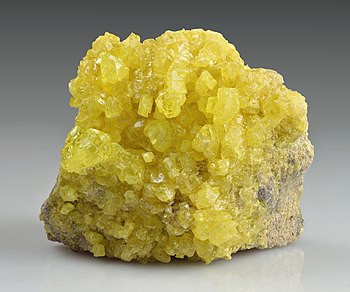
|
Sulfur is an abundant, multivalent and nonmetallic chemical element. It is a bright yellow, crystalline solid at room temperature. Being abundantly available in native form, the element was known in ancient times and is referred to in the Torah (in the Book of Genesis). A natural form of sulfur known as shiliuhuang was known in China since the 6th century BC and found in Hanzhong. These sulfur crystals on a matrix, measuring 4.8 cm × 3.5 cm × 3 cm (1.9 in × 1.4 in × 1.2 in), was mined in Daniel Campos Province, Bolivia. Photograph credit: Ivar Leidus
Recently featured:
|
October 7
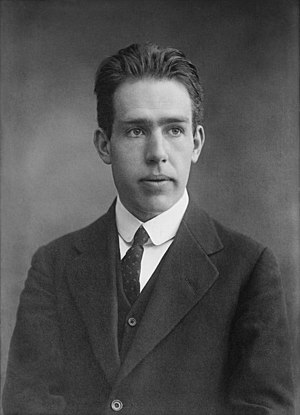
|
Niels Bohr (7 October 1885 – 18 November 1962) was a Danish physicist who made foundational contributions to understanding atomic structure and quantum theory. He advanced the theory of electrons travelling in orbits around the atom's nucleus, with the chemical properties of each element being largely determined by the number of electrons in the outer orbits of its atoms. He introduced the idea that an electron could drop from a higher-energy orbit to a lower one, in the process emitting a quantum of discrete energy. For his work, he received the Nobel Prize in Physics in 1922. Photograph credit: Bain News Service; restored by Bammesk
Recently featured:
|
October 8

|
The Seal of Texas is the official insignia of the U.S. state of Texas. The seal is used by the state governor on official business and depicts a white five-pointed star on a blue background encircled by an olive branch and an oak branch. It incorporates imagery from the Texas state coat of arms, as illustrated here by American engraver Henry Mitchell in State Arms of the Union, published in 1876 by Louis Prang. Illustration credit: Henry Mitchell; restored by Andrew Shiva
Recently featured:
|
October 9
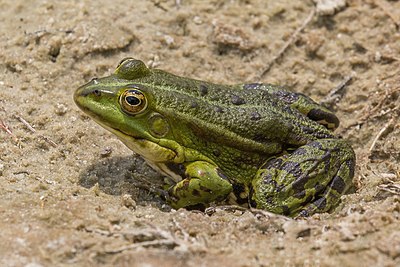
|
The marsh frog (Pelophylax ridibundus) is a species of amphibian native to Europe and parts of Asia. It is the largest type of frog in most of its range, growing to a snout-to-vent length of around 100 mm (4 in); tadpoles can reach up to 190 mm (7.5 in) in length, but this usually occurs in places with long winters where the tadpole has time to grow. Marsh frogs hibernate during the winter, either underwater or in burrows, and are able to use the Earth's magnetic field to locate breeding ponds. This marsh frog was photographed in Kampinos National Park, Poland. Photograph credit: Charles James Sharp
Recently featured:
|
October 10
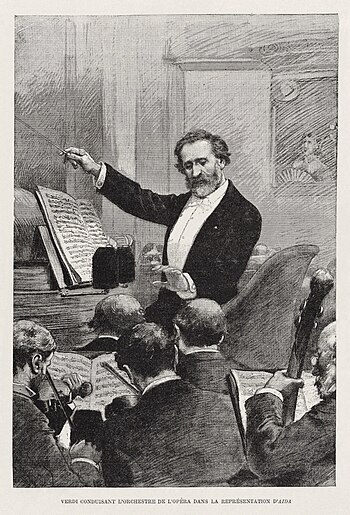
|
Giuseppe Verdi (1813–1901) was an Italian composer best known for his operas. He came to dominate the Italian opera scene after the era of Gioachino Rossini, Gaetano Donizetti and Vincenzo Bellini, whose works significantly influenced him. He is depicted here conducting the orchestra of the Paris Opera premiere of Aida (sung in French) at the Palais Garnier on 22 March 1880. The illustration was published in the 3 April 1880 edition of Le Monde illustré. Illustration credit: Adrien Marie; restored by Adam Cuerden
Recently featured:
|
October 11
Subpage 1
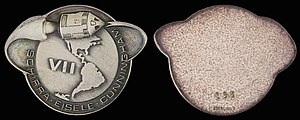
|
NASA space-flown Apollo medallions were mission-specific commemorative medallions which were approved by NASA and carried aboard the mission spacecraft into orbit. Apollo 7 (October 11 – 22, 1968) was the first crewed flight in NASA's Apollo program, and saw the resumption of human spaceflight by the agency after the fire that killed the three Apollo 1 astronauts during a launch rehearsal test on January 27, 1967. The Apollo 7 astronauts, Wally Schirra, Walter Cunningham and Donn F. Eisele, took part in the first live television broadcast from an American spacecraft. The medallions were struck by the Robbins Company in sterling silver and ordered by the mission crew as a personal memento of their flight; they were often taken to the lunar surface in the landing module. A total of over 3,000 Robbins medallions were flown into space across the 12 crewed flights of the Apollo program. Photograph credit: Heritage Auctions; commissioned by the NASA astronaut office
Recently featured:
|
Subpage 2
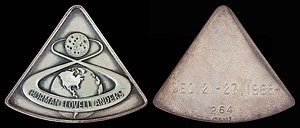
|
NASA space-flown Apollo medallions were mission-specific commemorative medallions which were approved by NASA and carried aboard the mission spacecraft into orbit. Apollo 8 (December 21 – 27, 1968) was the first crewed spacecraft to leave low Earth orbit, and also the first human spaceflight to reach another astronomical object, the Moon, which the crew orbited without landing. The astronauts, Frank Borman, James Lovell, and William Anders, were the first humans to witness and photograph an earthrise. The medallions were struck by the Robbins Company in sterling silver and ordered by the mission crew as a personal memento of their flight. A total of over 3,000 Robbins medallions were flown into space across the 12 crewed flights of the Apollo program. Photograph credit: Heritage Auctions; commissioned by the NASA astronaut office
Recently featured:
|
Subpage 3

|
NASA space-flown Apollo medallions were mission-specific commemorative medallions which were approved by NASA and carried aboard the mission spacecraft into orbit. Apollo 9 (March 3 – 13, 1969) was the third human spaceflight in NASA's Apollo program. Flown in low Earth orbit, it was the second crewed Apollo mission that the United States launched via a Saturn V rocket. The three-man crew consisted of James McDivitt, David Scott, and Rusty Schweickart; during the mission they tested systems and procedures critical to landing on the Moon, including the lunar module engines, backpack life support systems, navigation systems and docking maneuvers. The medallions were struck by the Robbins Company in sterling silver and ordered by the mission crew as a personal memento of their flight. A total of over 3,000 Robbins medallions were flown into space across the 12 crewed flights of the Apollo program. Photograph credit: Heritage Auctions; commissioned by the NASA astronaut office
Recently featured:
|
Subpage 4

|
NASA space-flown Apollo medallions were mission-specific commemorative medallions which were approved by NASA and carried aboard the mission spacecraft into orbit. Apollo 10 (May 18 – 26, 1969) was the fourth crewed mission in the United States Apollo program, and the second (after Apollo 8) to orbit the Moon. While astronaut John Young remained in the Command Module orbiting the Moon, astronauts Thomas Stafford and Gene Cernan test flew the Apollo Lunar Module but did not land. The medallions were struck by the Robbins Company in sterling silver and ordered by the mission crew as a personal memento of their flight. A total of over 3,000 Robbins medallions were flown into space across the 12 crewed flights of the Apollo program. Photograph credit: Heritage Auctions; commissioned by the NASA astronaut office
Recently featured:
|
Subpage 5
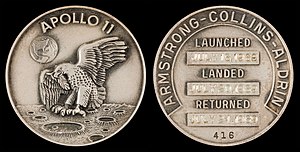
|
NASA space-flown Apollo medallions were mission-specific commemorative medallions which were approved by NASA and carried aboard the mission spacecraft into orbit. Apollo 11 (July 16–24, 1969) was the spaceflight that first landed humans on the Moon. Commander Neil Armstrong and lunar module pilot Buzz Aldrin formed the American crew that landed the Apollo Lunar Module Eagle on the lunar surface on July 20, 1969, at 20:17 UTC. The medallions were struck by the Robbins Company in sterling silver and ordered by the mission crew as a personal memento of their flight; they were often taken to the lunar surface in the landing module. A total of over 3,000 Robbins medallions were flown into space across the 12 crewed flights of the Apollo program. Photograph credit: Heritage Auctions; commissioned by the NASA astronaut office
Recently featured:
|
Subpage 6

|
NASA space-flown Apollo medallions were mission-specific commemorative medallions which were approved by NASA and carried aboard the mission spacecraft into orbit. Apollo 12 (November 14 – 24, 1969) was the sixth crewed flight in the United States Apollo program and the second to land on the Moon. It was launched on November 14, 1969, from the Kennedy Space Center, Florida. Commander Charles "Pete" Conrad and Lunar Module Pilot Alan L. Bean performed just over one day and seven hours of lunar surface activity while Command Module Pilot Richard F. Gordon remained in lunar orbit. The medallions were struck by the Robbins Company in sterling silver and ordered by the mission crew as a personal memento of their flight; they were often taken to the lunar surface in the landing module. A total of over 3,000 Robbins medallions were flown into space across the 12 crewed flights of the Apollo program. Photograph credit: Heritage Auctions; commissioned by the NASA astronaut office
Recently featured:
|
Subpage 7

|
NASA space-flown Apollo medallions were mission-specific commemorative medallions which were approved by NASA and carried aboard the mission spacecraft into orbit. Apollo 13 (April 11 – 17, 1970) was the seventh crewed mission in the Apollo space program, but the intended lunar landing was aborted after an oxygen tank in the service module failed two days into the mission. The commander, Jim Lovell, with crew members Jack Swigert and Fred Haise, were brought safely back to Earth, using the lunar module as a lifeboat. The medallions were struck by the Robbins Company in sterling silver and ordered by the mission crew as a personal memento of their flight; they were often taken to the lunar surface in the landing module. A total of over 3,000 Robbins medallions were flown into space across the 12 crewed flights of the Apollo program. Photograph credit: Heritage Auctions; commissioned by the NASA astronaut office
Recently featured:
|
Subpage 8

|
NASA space-flown Apollo medallions were mission-specific commemorative medallions which were approved by NASA and carried aboard the mission spacecraft into orbit. Apollo 14 (January 31, 1971 – February 9, 1971) was the eighth crewed mission in the United States Apollo program and the third to land on the Moon. While Commander Alan Shepard and Lunar Module Pilot Edgar Mitchell landed, Command Module Pilot Stuart Roosa remained in lunar orbit, performing scientific experiments and photographing the Moon, including the landing site of the future Apollo 16 mission. The medallions were struck by the Robbins Company in sterling silver and ordered by the mission crew as a personal memento of their flight; they were often taken to the lunar surface in the landing module. A total of over 3,000 Robbins medallions were flown into space across the 12 crewed flights of the Apollo program. Photograph credit: Heritage Auctions; commissioned by the NASA astronaut office
Recently featured:
|
Subpage 9

|
NASA space-flown Apollo medallions were mission-specific commemorative medallions which were approved by NASA and carried aboard the mission spacecraft into orbit. Apollo 15 (July 26 – August 7, 1971) was the ninth crewed mission in the United States' Apollo program and the fourth to land on the Moon. It was the first J mission, with a longer stay on the Moon and a greater focus on science than earlier landings. Commander David Scott and Lunar Module Pilot James Irwin landed and explored the local area using the Lunar Roving Vehicle, while Command Module Pilot Alfred Worden stayed on board. The medallions were struck by the Robbins Company in sterling silver and ordered by the mission crew as a personal memento of their flight; they were often taken to the lunar surface in the landing module. A total of over 3,000 Robbins medallions were flown into space across the 12 crewed flights of the Apollo program. Photograph credit: Heritage Auctions; commissioned by the NASA astronaut office
Recently featured:
|
Subpage 10

|
NASA space-flown Apollo medallions were mission-specific commemorative medallions which were approved by NASA and carried aboard the mission spacecraft into orbit. Apollo 16 (April 16 – 27, 1972) was the tenth crewed mission in the United States Apollo space program, and the fifth and next-to-last to land on the Moon. It featured an extended stay on the lunar surface, a focus on science, and the use of the Lunar Roving Vehicle. The mission was crewed by Commander John Young, Lunar Module Pilot Charles Duke and Command Module Pilot Ken Mattingly. The medallions were struck by the Robbins Company in sterling silver and ordered by the mission crew as a personal memento of their flight; they were often taken to the lunar surface in the landing module. A total of over 3,000 Robbins medallions were flown into space across the 12 crewed flights of the Apollo program. Photograph credit: Heritage Auctions; commissioned by the NASA astronaut office
Recently featured:
|
Subpage 11

|
NASA space-flown Apollo medallions were mission-specific commemorative medallions which were approved by NASA and carried aboard the mission spacecraft into orbit. Apollo 17 (December 7 – 19, 1972) was the final Moon landing mission of NASA's Apollo program, and remains the most recent time humans have traveled beyond low Earth orbit and also the most recent time humans have set foot on the Moon. The crew consisted of Commander Gene Cernan, Lunar Module Pilot Harrison Schmitt, and Command Module Pilot Ronald Evans The medallions were struck by the Robbins Company in sterling silver and ordered by the mission crew as a personal memento of their flight; they were often taken to the lunar surface in the landing module. A total of over 3,000 Robbins medallions were flown into space across the 12 crewed flights of the Apollo program. Photograph credit: Heritage Auctions; commissioned by the NASA astronaut office
Recently featured:
|
October 12
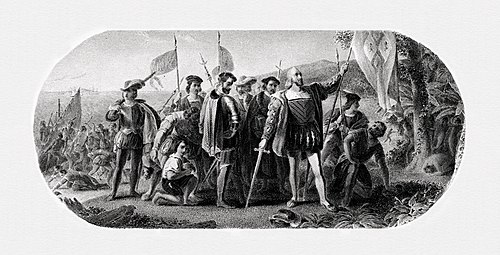
|
|
Artists producing banknotes in Colonial America began experimenting with copper plates as an alternative to wood engraving in the early 18th century. Applied to the production of paper currency, copper-plate engraving, and later steel engraving, enabled banknote design and printing to rapidly advance during the 19th century. This engraved vignette appeared on certain United States five-dollar bills issued in 1875. Produced for the Department of the Treasury's Bureau of Engraving and Printing, the engraving is of John Vanderlyn's painting Landing of Columbus, which hangs in the United States Capitol rotunda. It depicts Christopher Columbus landing on San Salvador Island on October 12, 1492, on the first of his voyages to the New World. Engraving credit: Bureau of Engraving and Printing, after John Vanderlyn; restored by Andrew Shiva
Recently featured:
|
October 13
|
The N700 Series Shinkansen is a Japanese Shinkansen high-speed train with tilting capability developed jointly by JR Central and JR West. It has been used on the Tokaido and San'yō Shinkansen lines since 2007. This photograph shows the train travelling at approximately 300 km/h through Himeji Station, and was captured with a line scan camera using strip photography. Photograph credit: Dllu |
October 14

|
Ferdinand VII of Spain (14 October 1784 – 29 September 1833) was King of Spain during the early- to mid-19th century. He reigned over the Spanish Kingdom in 1808 and again from 1813 until his death in 1833. This oil-on-canvas portrait of Ferdinand in his robes of state was painted by Francisco Goya in 1815, and is in the collection of the Museo del Prado in Madrid. Painting credit: Francisco Goya |
October 15

|
The bee hummingbird (Mellisuga helenae) is endemic to Cuba and is the smallest bird in the world and smallest known dinosaur. This immature male has yet to develop the iridescent blue plumage of the adult. The bee hummingbird feeds mainly on nectar, probing deep into flowers with its bill and moving its tongue rapidly in and out. In the process of feeding, the bird picks up pollen on its bill and head. As it flies from flower to flower, it transfers the pollen, and in this way plays an important role in plant reproduction. In one day, the bee hummingbird may visit 1,500 flowers. Photograph credit: Charles J. Sharp |
October 16

|
William P. Fessenden (October 16, 1806 – September 8, 1869) was an American politician from the state of Maine. He served in the United States House of Representatives and the Senate before becoming Secretary of the Treasury under President Abraham Lincoln during the American Civil War. This line engraving of Fessenden was produced around 1902 by the Department of the Treasury's Bureau of Engraving and Printing (BEP) as part of a BEP presentation album of the first 42 secretaries of the treasury. Engraving credit: Bureau of Engraving and Printing; restored by Andrew Shiva
Recently featured:
|
October 17

|
The Old Cathedral, Brescia, or the Duomo Vecchio, is a Catholic church in Brescia, Italy. One of the most important examples of a round church in the Romanesque style, the rustic co-cathedral stands next to the New Cathedral. Photograph credit: Wolfgang Moroder
Recently featured:
|
October 18
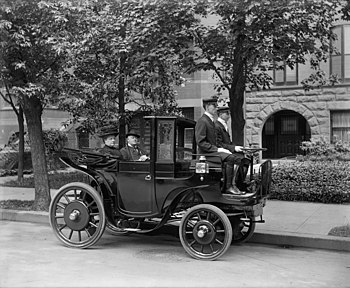
|
The Kriéger Company of Electric Vehicles was founded in 1898 by Louis Antoine Kriéger in France to manufacture automobiles. At least three battery-powered models were produced, the Brougham, the Landaulette and the Electrolette. This photograph shows U.S. senator George P. Wetmore of Rhode Island in a Kriéger Landaulette in around 1906. The senator is accompanied by a woman (presumably his wife), a chauffeur and a footman. Photograph credit: Harris & Ewing; restored by Adam Cuerden
Recently featured:
|
October 19

|
The red-billed gull (Chroicocephalus novaehollandiae scopulinus), also known as the tarāpung, is a member of the gull family, Laridae. Endemic to New Zealand, it is found throughout the country and on outlying islands including the Chatham Islands and the New Zealand Subantarctic Islands. Formerly considered a separate species, it is now usually treated as a subspecies of the silver gull. It regularly feeds on small fish, shell fish and worms, and sometimes berries, lizards and insects; it scavenges among urban waste in coastal towns. This red-billed gull was photographed in Christchurch. Photograph credit: Michal Klajban
Recently featured:
|
October 20
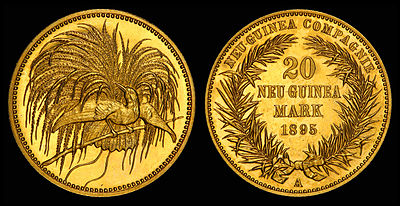
|
German New Guinea was a German colonial protectorate established in 1884 in the northeastern part of the island of New Guinea and several nearby island groups. The German New Guinea Company was founded in Berlin by Adolph von Hansemann and a syndicate of German bankers for the purpose of colonizing and exploiting the protectorate's resources. This gold coin, worth 20 New Guinean marks, was issued by the German New Guinea Company in 1895, and is now part of the National Numismatic Collection at the Smithsonian Institution. Design credit: German New Guinea Company; photographed by the National Numismatic Collection
Recently featured:
|
October 21
|
An mRNA vaccine is a type of vaccine that uses a copy of a molecule known as messenger RNA (mRNA) to produce an immune response. The vaccine transfects molecules of synthetic RNA into dendritic cells, where the vaccine functions as mRNA, causing the cells to build foreign protein that would normally be produced by a pathogen (such as a virus) or by a cancer cell. These protein molecules stimulate an adaptive immune response that teaches the body to identify and destroy the corresponding pathogen or cancer cell. This animated video illustrates how immunization with an mRNA COVID-19 vaccine stimulates an immune response against COVID-19 infection. Video credit: Swiss Academy of Natural Sciences
Recently featured:
|
October 22

|
Sarah Bernhardt (22 or 23 October 1844 – 26 March 1923) was a French stage actress who had lead roles in some of the most popular French plays of the late 19th and early 20th centuries. Rostand called her "the queen of the pose and the princess of the gesture", while Hugo praised her "golden voice". She made several theatrical tours around the world, and was one of the first prominent actresses to make sound recordings and to act in motion pictures. This photograph by Nadar was taken around 1864. Photograph credit: Nadar; restored by the Getty Center
Recently featured:
|
October 23

|
Wallace's flying frog (Rhacophorus nigropalmatus) is a moss frog found in tropical southeastern Asia. It is named after the British naturalist Alfred R. Wallace, who collected the first known specimen of the species. It lives almost exclusively in trees, and when threatened, or in search of prey, will leap from a branch and splay its four webbed feet; the membranes between its toes and the loose skin flaps on its sides catch the air as it falls, helping it to glide. This individual was photographed in Khao Sok National Park, Thailand. Photograph credit: Rushenb
Recently featured:
|
October 24

|
La Juive (The Jewess) is a grand opera in five acts by Fromental Halévy with an original French libretto by Eugène Scribe. It was first performed on 23 February 1835 at the Paris Opera. With the premise of an impossible love between a Christian man and a Jewish woman, the work has been seen by some as a plea for religious tolerance. This illustration shows the set design for the first act of La Juive for the inaugural production of the opera. Lithograph credit: Eugène Cicéri and Philippe Benoist; restored by Adam Cuerden
Recently featured:
|
October 25
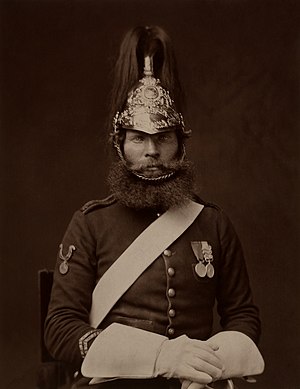
|
The 5th Dragoon Guards was a British army cavalry regiment, officially formed in January 1686 as Shrewsbury's Regiment of Horse. The unit was redesignated as heavy cavalry and was sent to the Crimean War in 1853, taking part in the Battle of Balaclava on 25 October 1854. This photograph shows Private Michael McNamara, of the 5th Dragoon Guards, and was part of a commissioned set of photographs taken at Aldershot for Queen Victoria in 1856. Photograph credit: Hughes & Mullins after Cundall & Howlett; restored by Adam Cuerden
Recently featured:
|
October 26

|
The rockwarbler (Origma solitaria) is a species of bird in the Australian warbler family Acanthizidae. It is found only in the Australian state of New South Wales, where its preferred habitat is woodland with cliffs and gullies and exposed sandstone or limestone rocks. Its nest is a hanging structure in a cave, made of grasses, roots, bark and moss, with spider web used as an adhesive. The species is listed as being of least concern by the International Union for Conservation of Nature. This rockwarbler was photographed in the Royal National Park. Photograph credit: John Harrison
Recently featured:
|
October 27

|
The Church of the Intercession on the Nerl is a Russian Orthodox church situated at the confluence of the Nerl and the Klyazma in Bogolyubovo, Vladimir Oblast. It was commissioned by Andrey Bogolyubsky, a 12th-century Russian grand prince, and has been little altered since. The building is constructed in white stone, and has one dome and four columns in the interior. Its proportions are elongated on purpose to make its outline seem slenderer, although this architectural solution restricts its use in holding services. In 1992, the church was inscribed on the UNESCO World Heritage List as part of the White Monuments of Vladimir and Suzdal. Photograph credit: Alexander Savin
Recently featured:
|
October 28

|
Wheat Fields is a series of paintings by the Dutch Post-Impressionist artist Vincent van Gogh. This 1889 work, entitled Enclosed Field with Ploughman, is one of many oil-on-canvas paintings he created that included wheat cultivation. He wrote to his brother Theo of his approach to painting, "One must undertake with confidence, with a certain assurance that one is doing a reasonable thing, like the farmer who drives his plow ... (one who) drags the harrow behind himself. If one hasn't a horse, one is one's own horse." This painting is in the collection of the Museum of Fine Arts, Boston. Painting credit: Vincent van Gogh
Recently featured:
|
October 29
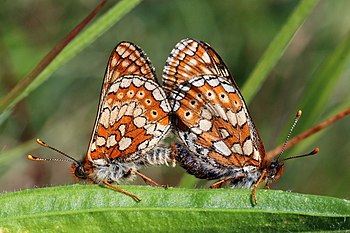
|
The marsh fritillary (Euphydryas aurinia) is a species of butterfly of the family Nymphalidae, found in the Palearctic region. Females are larger and less vibrant in color than males. Due to their short lifespan, females mate soon after they emerge from the chrysalis. They bear so many eggs that they crawl to nearby vegetation to start laying them, being unable to fly far until they are less burdened. These two marsh fritillaries were photographed in Dorset, England, while mating; the male is on the left of the image and the female on the right. Photograph credit: Charles James Sharp
Recently featured:
|
October 30

|
George M. Bibb (October 30, 1776 – April 4, 1859) was an American lawyer and politician who served as the seventeenth United States secretary of the treasury from 1844 to 1845. He was also Chief Justice of the Kentucky Court of Appeals, and twice represented Kentucky as a U.S. senator, serving from 1811 to 1814 and from 1829 to 1835. This line engraving of Bibb was produced around 1902 by the Department of the Treasury's Bureau of Engraving and Printing (BEP) as part of a BEP presentation album of the first 42 secretaries of the treasury. Engraving credit: Bureau of Engraving and Printing; restored by Andrew Shiva
Recently featured:
|
October 31

|
The over-the-shoulder shot is a camera angle used in film and television, in which the camera is placed above and behind one of the participants. In this lithographic colour poster, which advertised a show in 1896, it is used to show the scene from the perspective of an audience member watching images projected by a Vitascope, an early type of film projector. Poster credit: Metropolitan Print Company; restored by Adam Cuerden
Recently featured:
|
Picture of the day archives and future dates
















